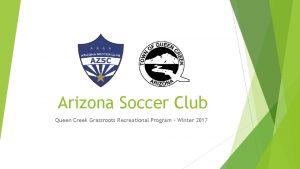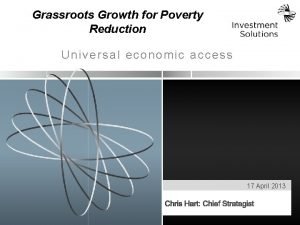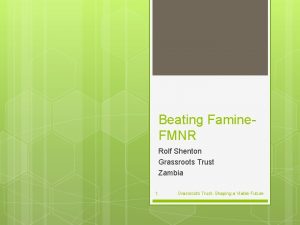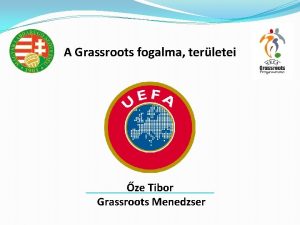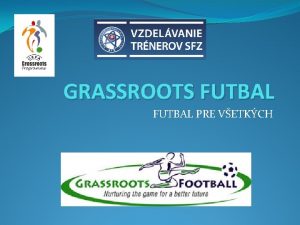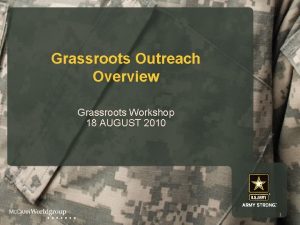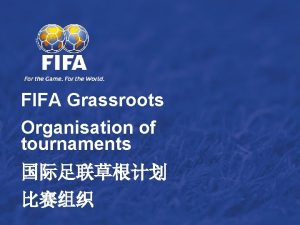What Follows Emerging Lifecycles of Grassroots Groups Grassroots








- Slides: 8

What Follows Emerging? Lifecycles of Grassroots Groups Grassroots Grantmakers Topical Conference Call July 24, 2007

A Working Definition of Grassroots Groups Grassroots Grantmakers is especially interested in grassroots groups that share the following common characteristics: • They arise from people’s shared experience of and interest in a place • They are quintessentially and specifically local • They are directly and immediately responsive to the needs and wishes of those involved • The major part of the work is done not only for the people involved but also by them, with little or no paid staff, often without much specialized expertise, and usually without big budgets or other large resource reservoirs • They have members – either implicitly or explicitly defined • They vary in structure and formality, from more formal (with elected officers/or a board of directors, written by-laws, and members who pay dues) to very informal (without any officers or formal memberships – perhaps even without a name) • They work with a clear sense of who “belongs” and with the understanding that the group is a vehicle for the collective action of the members. • They range in size from 2 members to hundreds of members • They can be temporary, transient or on-going • They can be focused on a single issue or task or can work on multiple issues or tasks

More about grassroots groups n The common denominator among grassroots groups – what distinguishes them from the non-profit organizations that are the most common recipients of foundation grants – is a structure that allows people who are bound together by their common experience of and interest in “place” to move their shared agenda forward in a way that depends on their collective commitment, energy, passion, and skills. n For grassroots groups, both the process and the product of their work contributes to a community’s strength and resiliency – with the process (being part of the group, sharing interests, hopes and frustrations, deciding to act, planning the activity, finding more people to help, doing the activity, celebrating success) as a critical vehicle for connecting people and strengthening the web of relationships in a community - and the product (a playground, a parade, newsletter, a clean-up, neighborhood watch, etc) as a tangible investment in the community’s livability. n Nonprofit agencies, with their orientation toward service and operational efficiency, are less about “who” and “how” and more about “what” – particularly in this time of fascination with outcomes. Grassroots groups are as much – maybe even more – about “who” and “how” than “what”. The assumption that we make is that this investment in “who” and “how” is an essential investment in the “what” of stronger communities.

Classic first three phases for nonprofits – based on default to hierarchy PHASE 1 CREATIVITY PHASE 2 DIRECTION PHASE 3 DELEGATION Cause Efficiency of operations Building equilibrium through expansion of component pieces DECISION MAKING Informal – ad-hoc Codified, formal, centralized. Divisions are based on function Decentralized – ideas are often generated at program level TOP MANAGEMENT Individualistic – small group or personality driven Top down and directive. One or a very few decision makers Delegation to program units and functional departments CONTROL SYSTEM Results – impact and reports and reactions from constituency are central Reporting to performance standards and procedures Held mostly at unit level - sometimes tracked through accreditations REWARD Mission / Meaning Salary Titles, promotions, political autonomy MANAGEMENT FOCUS CRISIS IN LEADERSHIP CRISIS IN AUTONOMY CRISIS IN CONTROL

Industrial Era Top-Down Hierarchical Information Era Permeable / Participatory

Second Stage Supporting Centralization 1 st Stage Second Stage Supporting Skilled Inclusion

Market Feedback Models FOR-PROFIT MARKET Business feedback with financial consequences Customer buyer & user NONPROFIT MARKET Nonprofit Organization feedback with financial consequences Customer (buyer) Customer (user)

The opportunity for continued learning n Continued learning via a peer learning circle n Discussion/sharing via on-line forum n Share resources/articles n Request specific help n Document bank (members only)




